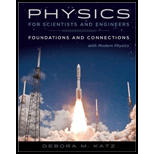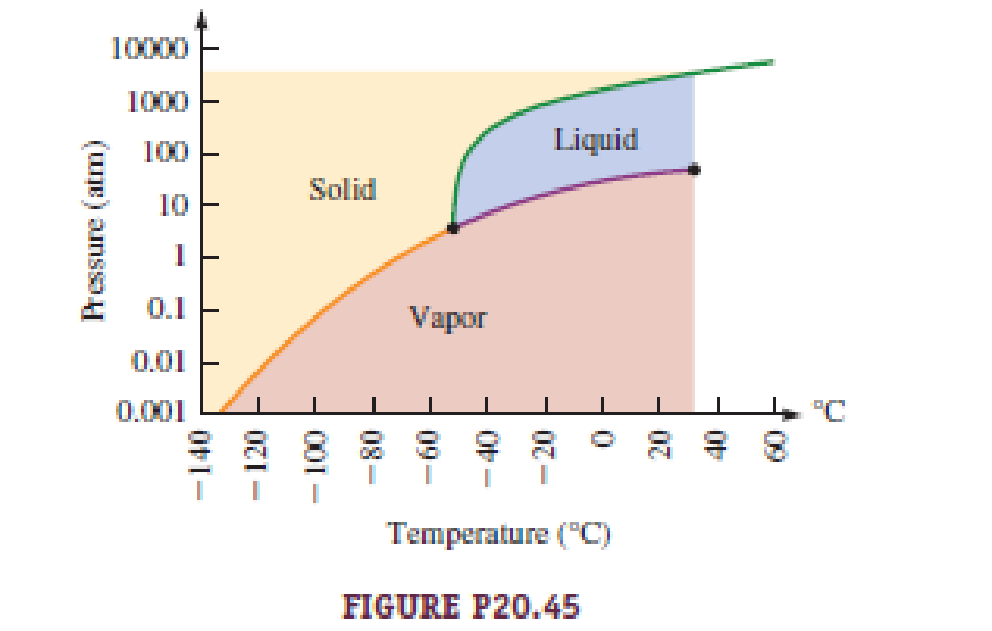
Physics For Scientists And Engineers: Foundations And Connections, Extended Version With Modern Physics
1st Edition
ISBN: 9781305259836
Author: Debora M. Katz
Publisher: Cengage Learning
expand_more
expand_more
format_list_bulleted
Textbook Question
Chapter 20, Problem 45PQ
Figure P20.45 shows a phase diagram of carbon dioxide in terms of pressure and temperature, a. Use the phase diagram to explain why dry ice (solid carbon dioxide) sublimates into vapor at atmospheric pressure rather than melting into a liquid. At what temperature does the dry ice sublimate when at atmospheric pressure? b. Estimate what pressure would be needed to liquefy carbon dioxide at room temperature.

Expert Solution & Answer
Trending nowThis is a popular solution!

Students have asked these similar questions
4. Does the period of simple harmonic motion depend on amplitude?
Show that x(t) = A cos (wt) + B sin (wt) is a solution to the differential equation of the mass/spring system
2. List three places besides in springs where Hooke's law applies.
Chapter 20 Solutions
Physics For Scientists And Engineers: Foundations And Connections, Extended Version With Modern Physics
Ch. 20.2 - In Example 20.1, we found that the rms value of a...Ch. 20.3 - If the temperature of a gas is doubled, what...Ch. 20.3 - Prob. 20.3CECh. 20.5 - Prob. 20.4CECh. 20.7 - Prob. 20.5CECh. 20.8 - Prob. 20.6CECh. 20 - Prob. 1PQCh. 20 - Prob. 2PQCh. 20 - Prob. 3PQCh. 20 - Prob. 4PQ
Ch. 20 - Prob. 5PQCh. 20 - Prob. 6PQCh. 20 - Prob. 7PQCh. 20 - Prob. 8PQCh. 20 - Particles in an ideal gas of molecular oxygen (O2)...Ch. 20 - Prob. 10PQCh. 20 - Prob. 11PQCh. 20 - Prob. 12PQCh. 20 - Prob. 13PQCh. 20 - Prob. 14PQCh. 20 - The mass of a single hydrogen molecule is...Ch. 20 - Prob. 16PQCh. 20 - The noble gases neon (atomic mass 20.1797 u) and...Ch. 20 - Prob. 18PQCh. 20 - Prob. 19PQCh. 20 - Prob. 20PQCh. 20 - Prob. 22PQCh. 20 - Prob. 23PQCh. 20 - Prob. 24PQCh. 20 - Prob. 25PQCh. 20 - Prob. 26PQCh. 20 - Prob. 27PQCh. 20 - Prob. 28PQCh. 20 - Consider the Maxwell-Boltzmann distribution...Ch. 20 - Prob. 30PQCh. 20 - Prob. 31PQCh. 20 - Prob. 32PQCh. 20 - Prob. 33PQCh. 20 - Prob. 34PQCh. 20 - Prob. 35PQCh. 20 - Prob. 36PQCh. 20 - Prob. 37PQCh. 20 - Prob. 38PQCh. 20 - Prob. 39PQCh. 20 - Prob. 40PQCh. 20 - Prob. 41PQCh. 20 - Prob. 42PQCh. 20 - Prob. 43PQCh. 20 - Prob. 44PQCh. 20 - Figure P20.45 shows a phase diagram of carbon...Ch. 20 - Prob. 46PQCh. 20 - Prob. 47PQCh. 20 - Consider water at 0C and initially at some...Ch. 20 - Prob. 49PQCh. 20 - Prob. 50PQCh. 20 - Prob. 51PQCh. 20 - Prob. 52PQCh. 20 - Prob. 53PQCh. 20 - Prob. 54PQCh. 20 - Prob. 55PQCh. 20 - Prob. 56PQCh. 20 - Consider again the box and particles with the...Ch. 20 - Prob. 58PQCh. 20 - The average kinetic energy of an argon atom in a...Ch. 20 - For the exam scores given in Table P20.60, find...Ch. 20 - Prob. 61PQCh. 20 - Prob. 62PQCh. 20 - Prob. 63PQCh. 20 - Prob. 64PQCh. 20 - Prob. 65PQCh. 20 - Prob. 66PQCh. 20 - Determine the rms speed of an atom in a helium...Ch. 20 - Consider a gas filling two connected chambers that...Ch. 20 - Prob. 69PQCh. 20 - Prob. 70PQCh. 20 - A 0.500-m3 container holding 3.00 mol of ozone...Ch. 20 - Prob. 72PQCh. 20 - Prob. 73PQ
Knowledge Booster
Learn more about
Need a deep-dive on the concept behind this application? Look no further. Learn more about this topic, physics and related others by exploring similar questions and additional content below.Similar questions
- 1. What is the spring constant of a spring that starts 10.0 cm long and extends to 11.4 cm with a 300 g mass hanging from it?arrow_forwardplease help me solve all parts of this question from physics. thanks so much in advance! :)))arrow_forwardA fluid with density 263 kg/m3 flows through a pipe of varying diameter and height. At location 1 the flow speed is 13.5 m/s and the diameter of the pipe is 7.4 cm down to location 2 the pipe diameter is 16.9 cm. Location 1 is 6.3 meters higher than location 2. What is the difference in pressure P2 - P1? Using units in Pascals and use g = 9.81 m/s2.arrow_forward
- The kitchen had a temperature 46 degrees Fahrenheit and was converted it to Kelvin. What is the correct number for this temperature (46 F) on the Kelvin scale?arrow_forwardWater is traveling at a speed of 0.65 m/s through a pipe with a cross-section radius of 0.23 meters. The water enters a section of pipe that has a smaller radius, only 0.11 meters. What is the speed of the water traveling in this narrower section of pipe?arrow_forwardA particular water pipe has a radius of 0.28 meters. If the pipe is completely filled with water, moving with average velocity 0.45 m/s, what is the flow rate of water through the pipe with units of cubic meters of water per second?arrow_forward
- Water is flowing through a horizontal pipe with two segments. In one segment, the water flows at a speed v1 = 4.52 m/s. In the second segment the speed of the water is v2 = 2.38 m/s. Based on Bernoulli's Principle, what is the difference in pressure (P2 - P1) between the two segments? Assume that the density of the water is 997 kg/m3 and give your answer as the number of Pascals (i.e. N/m2).arrow_forwardWater from the faucet is supplied to the hose at a rate of 0.00057 m3/s. At what speed (number of meters per second) does the water exit the nozzle if the cross sectional area of the narrow nozzle is 2.1 x 10-6 m2?arrow_forwardJason Fruits/Indiana University Research Communications Silver/ silver oxide Zinc zinc/oxidearrow_forward
- Car P moves to the west with constant speed v0 along a straight road. Car Q starts from rest at instant 1, and moves to the west with increasing speed. At instant 5, car Q has speed w0 relative to the road (w0 < v0). Instants 1-5 are separated by equal time intervals. At instant 3, cars P and Q are adjacent to one another (i.e., they have the same position). In the reference frame o f the road, at instant 3 i s the speed o f car Q greater than, less than, or equal to the speed of car P? Explain.arrow_forwardCar P moves to the west with constant speed v0 along a straight road. Car Q starts from rest at instant 1, and moves to the west with increasing speed. At instant 5, car Q has speed w0 relative to the road (w0 < v0). Instants 1-5 are separated by equal time intervals.arrow_forwardCar P moves to the west with constant speed v0 along a straight road. Car Q starts from rest at instant 1, and moves to the west with increasing speed. At instant 5, car Q has speed w0 relative to the road (w0 < v0). Instants 1-5 are separated by equal time intervals. Sketch and label a vector diagram illustrating the Galilean transformation of velocities that relates velocity of car P relative to the road, velocity of car Q relative to road, and velocity of car Q relative to car P at instant 3. In the frame of car P, at instant 3 is car Q moving to the west, moving to the east, or at rest? Explain.arrow_forward
arrow_back_ios
SEE MORE QUESTIONS
arrow_forward_ios
Recommended textbooks for you
 Physics for Scientists and Engineers: Foundations...PhysicsISBN:9781133939146Author:Katz, Debora M.Publisher:Cengage Learning
Physics for Scientists and Engineers: Foundations...PhysicsISBN:9781133939146Author:Katz, Debora M.Publisher:Cengage Learning Physics for Scientists and Engineers, Technology ...PhysicsISBN:9781305116399Author:Raymond A. Serway, John W. JewettPublisher:Cengage Learning
Physics for Scientists and Engineers, Technology ...PhysicsISBN:9781305116399Author:Raymond A. Serway, John W. JewettPublisher:Cengage Learning College PhysicsPhysicsISBN:9781938168000Author:Paul Peter Urone, Roger HinrichsPublisher:OpenStax College
College PhysicsPhysicsISBN:9781938168000Author:Paul Peter Urone, Roger HinrichsPublisher:OpenStax College Principles of Physics: A Calculus-Based TextPhysicsISBN:9781133104261Author:Raymond A. Serway, John W. JewettPublisher:Cengage Learning
Principles of Physics: A Calculus-Based TextPhysicsISBN:9781133104261Author:Raymond A. Serway, John W. JewettPublisher:Cengage Learning Physics for Scientists and EngineersPhysicsISBN:9781337553278Author:Raymond A. Serway, John W. JewettPublisher:Cengage Learning
Physics for Scientists and EngineersPhysicsISBN:9781337553278Author:Raymond A. Serway, John W. JewettPublisher:Cengage Learning Physics for Scientists and Engineers with Modern ...PhysicsISBN:9781337553292Author:Raymond A. Serway, John W. JewettPublisher:Cengage Learning
Physics for Scientists and Engineers with Modern ...PhysicsISBN:9781337553292Author:Raymond A. Serway, John W. JewettPublisher:Cengage Learning

Physics for Scientists and Engineers: Foundations...
Physics
ISBN:9781133939146
Author:Katz, Debora M.
Publisher:Cengage Learning

Physics for Scientists and Engineers, Technology ...
Physics
ISBN:9781305116399
Author:Raymond A. Serway, John W. Jewett
Publisher:Cengage Learning

College Physics
Physics
ISBN:9781938168000
Author:Paul Peter Urone, Roger Hinrichs
Publisher:OpenStax College

Principles of Physics: A Calculus-Based Text
Physics
ISBN:9781133104261
Author:Raymond A. Serway, John W. Jewett
Publisher:Cengage Learning

Physics for Scientists and Engineers
Physics
ISBN:9781337553278
Author:Raymond A. Serway, John W. Jewett
Publisher:Cengage Learning

Physics for Scientists and Engineers with Modern ...
Physics
ISBN:9781337553292
Author:Raymond A. Serway, John W. Jewett
Publisher:Cengage Learning
Thermodynamics: Crash Course Physics #23; Author: Crash Course;https://www.youtube.com/watch?v=4i1MUWJoI0U;License: Standard YouTube License, CC-BY